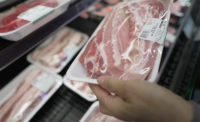Reducing the Risk
By Sam Gazdziak, Senior Editor
Knowledge and technology have combined to make the meat industry less dangerous for its workers.
Almost 15 years ago, anyone who worked in the meat industry had nearly a 30 percent chance of suffering a work-related injury or illness. Since that time, the industry as a whole has recognized the necessity of worker safety and has made tremendous strides in making the industry safer.
In 1991, according to the Bureau of Labor Statistics, the number of Total Recordable Cases (TRC) of injuries or illnesses in the meat industry was 30.0, meaning 30 employees out of 100 suffered an injury or illness on the job. In 2003, the most recent year of which data is available, that number had dropped to 10.3.
That downward trend was evident in all three industry groupings included in the data. Red meat slaughter TRC dropped from 45.5 to 12.9, meat processing went from 20.8 to 11.2, and the poultry industry went from 23.1 to 8.1.
“While we are very pleased as an industry with the improvement of worker and workplace safety, we’re still on the path,” says Dan McCausland, director of worker safety and human resources for the American Meat Institute (AMI), noting that overall private industry has an overall TRC of about 5.0. The meat packing and processing industries may never reach those numbers because of the nature of the work, but the trend in reducing injuries is one that should be continued.
McCausland says the changes in the industry are partly the result of a greater understanding of workplace safety. “In the meat industry where I grew up, it was more or less accepted that it was a tough place to work, and a certain number of cuts, breaks, and other problems went with the territory,” he explains. “The biggest single thing that has changed is the realization, both on the part of management and the workforce, is that you can, in fact, control safety.” It is now understood that many so-called “accidents” are almost planned events that occur when floors become slippery, or workers are given improper personal protective equipment.
Dangers in packing & processing
The kill floors of pork and beef plants have a number of risk areas, although that risk has been decreased, thanks to improved safety gear and new technology.
Pork slaughter lines have the dangers of accidental cuts and slices, but repetitive motion disorders are also common. “Loin pullers have issues with repetitive motion,” says Jeff Earnhart, executive vice president of Bunzl USA, St. Louis, MO. “Now there are machines that automatically pull the fat from the loins and, when used, have addressed the repetitive motion issues from this job. At one point, the leaf-lard pulling job also represented a significant risk for repetitive motion problems, but most plants now utilize leaf-lard pulling machines to do what used to be done manually.”
Technological advances have also improved the job of head-dropping in a pork slaughter line. In order to remove the head and expose the glands for inspection, McCausland says, the worker would have to cut the head off with a knife. “The hard part about that was separating the spinal cord, because you basically had to feel your way through that joint with the knife. Getting through that joint was extremely difficult.” He says that the addition of a hydraulic-powered shear to the kill floor has eliminated many of that job’s dangers.
Animal stunning presents a number of risks for employees, says Tom Byrnes, general manager, Omaha operations, for Bunzl. Bunzl offers the Applied electric hog stunner and the Magnum 25 Captive Bolt stunner for beef, both of which offer significant safety features for the operator. “As always, proper training, care, and maintenance of the stunning tools needs to be taken seriously,” Byrnes adds.
It’s not just the stunners who are at risk. “In both beef and pork harvesting plants, the ‘stickers’ have a dangerous job, as at any given time an improperly stunned animal can move or kick at the sticker, resulting in the sticker being the one getting stuck,” Byrnes says. Many plants use special helmets adapted with metal mesh material to protect the face, neck, and chest of the stickers.
Of course, packing and processing facilities face the risk of knife accidents. McCausland says that the advances in personal protective equipment have helped reduce that risk. “Metal mesh gloves used to come in two sizes — extra large and really, really big,” he says. “You could imagine putting a metal mesh glove of that size on a five-foot-tall employee. They weren’t able to wear them.” Now, personal protective equipment is available in a variety of sizes, types, and materials. “The PPE materials we have now are sufficiently better that they don’t impede the workers’ activity, and there are very few cases where you’d have trouble getting the workers to use them,” he says.
Protective clothing
Employees outside of the production floor also need to be properly protected from injuries. One of the hazards that meat processing facilities face is the electric arc flash hazard, notes Misty Johnson, marketing manager, flame-resistant clothing, for Cintas, Cincinnati, OH.
“More than two-thousand people are admitted annually to burn centers with severe arc flash burns. Most of these hospital admissions due to electrical accidents are from the arc flash burns, not necessarily the shock,” she says. Arc flashes can come from working with even small amounts of voltage, such as from changing a lightbulb.
For any employees who are exposed to electricity, such as plant maintenance workers, flame-resistant clothing is a must. The National Fire Prevention Association has come out with a standard, NFPA 70E, that specifies the type of clothing that must be worn, depending on the exposure. This could include anything from a face shield, voltage gloves, and leather protectors at Category 1, all the way to an arc suit, beekeepers’ hood and bib overalls at Category 4. “These are all products that we can help people with in complying with the standards,” Johnson says.
To determine a plant’s exposure level, Johnson recommends having an electrical engineer inspect the plant and determine the risk. The NFPA standard does have a “Simplified Approach to Compliance,” which recommends that companies supply their employees with Category 2 daily wear and Category 4 hazardous wear. Cintas’ product offerings for the daily wear include the Indura Ultra-Soft and Nomex clothing, which feature inherent flame resistance along with comfort and a professional appearance.
Proper clothing is also vital for anyone who will be spending significant time in cool temperatures, such as freezers. Given the fragile nature of meat, coolers and freezers are important, and the people who work in them have to be dressed to withstand the cold temperatures. Storage facilities can be right around the freezing point, and freezers are often below zero.
How long a person can stay in a freezer depends on the level of activity, says Ron Breakstone, president of Refrigiwear Inc., Dahlonega, GA. “Somebody who drives a forklift and spends his whole shift in a freezer, even if they get warm-up breaks, will need more protection than somebody who is constantly getting on and off a piece of material-handling equipment and is very active in pulling cases of product and delivering them to the loading area.” Generally, though, 45 minutes to an hour is a common amount of time in that environment.
Employees in that situation need to be flexible as well as warm. Breakstone says many workers use a pair of quilted overalls, and instead of a heavier jacket, prefer a sweatshirt and a fleece jacket or something similarly lightweight. “They may also need some reflectivity on the garments, so that they are visible quickly, because those are very fast-moving operations,” says Breakstone, who adds that slip-resistant footwear with a safety-toe protection is also important. NP
Safety wear suppliers participating in this article include:
Bunzl Distribution, phone (888) 997-5959, fax (314) 997-0247, e-mail jeff.earnhart@bunzlusa, or visit www.bunzldistribution.com
Cintas – The Service Profissionals, phone (800) CINTAS1, fax (513) 573-4232, e-mail info@cintas.com, or visit www.cintas.com
Refrigiwear, phone (800) 645-3744, fax (706) 864-5898, e-mail keepmewarm@refrigiwear.com, or visit www.refrigiwear.comOSHA’s Voluntary Protection Program
Since 1991, the meat and poultry processing and packing industries have seen a gradual decline in the number of injuries, according to the Occupational Safety & Health Administration (OSHA). “The industry has made very considerable and significant improvements in the last ten or twelve years,” notes Dan McCausland, director of worker safety and human resources for the American Meat Institute (AMI).
McCausland says he has lately seen more dialogue and cooperation between the meat industry and OSHA. Working with OSHA in a cooperative manner has proven more successful than merely trying to comply with OSHA’s regulations. The AMI has allied with OSHA in improving ergonomics and safety materials for non-English-speaking employees. There are also several facilities participating in OSHA’s Voluntary Protection Program, which McCausland calls an ISO 9000 program for safety. Companies participating in the program must first submit to a very thorough inspection program, and once they pass that inspection, they are certified as a VPP Star, Merit, or Star Demonstration work site.
Aurora Packing Co., Aurora, IL, has been involved with the VPP program since the program’s inception in 1989. It is one of 49 companies in the “Food and Kindred Products” category. Other meat packers and processors with VPP Star facilities are Taylor Packing Co., Wyalusing, PA; Armour Swift-Eckrich, Jonesboro, AR and Saint Charles, IL; Cargill Turkey Products, Harrisonburg, VA; and Kraft, Kirksville, MO, Springfield, MO, and Medford, WI.
Michael Fagel, PhD, corporate risk manager for Aurora Packing, says that the VPP program requires massive commitment from both management and employees. “You don’t just meet minimum OSHA standards, because VPP is higher than OSHA standards. You really have to make sure you have all your ducks in a row,” he says.
The key advantage to being in the VPP program is increased safety, “which is an advantage you can’t put dollars on,” Fagel notes. “What we’ve done is empowered the workers to do things better. That means give them the right training, quality training in a language they can understand.”
As a result of being in the VPP program, Aurora has made hundreds, if not thousands of safety improvements, notes Fagel. “Many of them were brought to us by employees. It’s active input and involvement from the people who do the job. Who knows better how to do a job than the person who’s doing it?”
Fagel says that getting employees to accept the VPP standards required a gradual change. “It’s a culture change; you can’t just make an edict and say ‘You shalt do this now,’” he says. “It’s gradual, and it took years.”



Report Abusive Comment